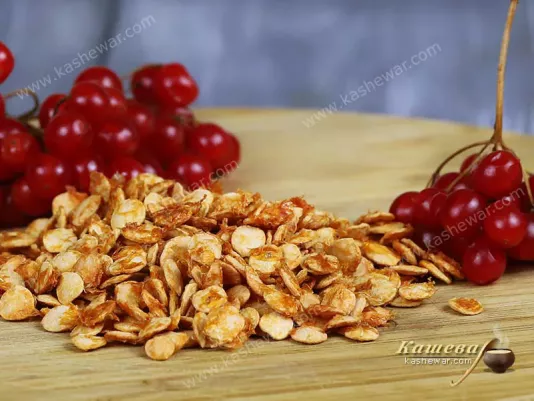Viburnum Seed Coffee
Viburnum seed coffee – long forgotten, but it's a pity - there are a lot of useful substances in the seeds.

Viburnum seeds are a little miracle often underestimated. Over years of cooking, I’ve realized that these hard, glossy grains hold a concentrated essence of flavor and goodness. They contain fatty acids, antioxidants, and natural compounds that add depth to dishes and support the body during the cold season. I never throw away the seeds after making jam or fruit drink: I dry them, store them in a dry place, and later use them as seasoning or a base for infusions. When processed properly, they don’t taste bitter but instead give a coffee-like tone with hints of wild cherry. In my practice, they produce a unique powder that makes cookies crumbly and sauces aromatic. All you need is a bit of patience and attention to detail, since these seeds appreciate precision and cleanliness in handling.
I always say: everything begins with the choice of raw material. Over the years, I’ve learned to distinguish naturally ripened viburnum from the one picked too early. Good seeds have a shiny, hard surface without cracks or dark spots. I pick the berries after the first frosts – that’s when they’re sweeter and the seeds are denser. It’s important not to overdry the fruit during drying: if the temperature is too high, the kernels lose their oils, and the flavor becomes flat. That’s why I dry viburnum in the oven at low heat with the door slightly open or simply in the attic with good ventilation. When the grains are fully dry, I store them in glass jars with airtight lids, away from light. I avoid plastic containers because they can transfer odor. Properly dried seeds have no musty smell, only a mild bitterness. If moisture gets inside, the seeds can spoil – that’s why I always keep a small packet of rice near the jar as a natural desiccant. It’s a simple but reliable trick I’ve learned through experience.
Before grinding or adding the seeds to dishes, I rinse them thoroughly to remove any pulp residue that might spoil the flavor. Then I always dry them again at a low temperature to preserve the natural oil inside. From my experience, if you rush and grind raw seeds, they develop a bitter aftertaste. The best results come when I roast them for a few minutes in a dry cast-iron pan – until a light caramel aroma appears. This makes the seeds more brittle and easier to grind in a coffee grinder. Ground, they resemble the aroma of roasted nuts and coffee, which works especially well in baked goods. When baking bread or cookies, I add a teaspoon of this powder to give the dough an earthy tone. And if I want to make an infusion, I pour boiling water over the crushed seeds, let it steep covered, and add a spoon of honey. I do everything intuitively, guided by scent and color – they tell me when the flavor is balanced.
When I first tried roasting viburnum seeds, I ruined them – the heat was too high. Since then, I always control the temperature. Medium heat is enough for roasting, and I never set the oven above 120°C (250°F). Under these conditions, the seeds gradually release moisture without charring. If overroasted, they lose their natural oils and the aroma turns sharp. In my practice, I use two methods: slow baking for storage and quick roasting before grinding. The first ensures long shelf life, the second gives a brighter flavor. When making an infusion, I dry the seeds only until warm so the alcohol extracts aromas better. Of course, cleanliness is crucial: even a drop of water in hot oil can cause foaming or burning. I’ve learned to listen to the scent – as soon as a malty note appears, I turn off the heat. That’s the moment when the seeds have their fullest aroma and an even texture, ready for use.
Viburnum seeds have a complex aroma: a mix of bitterness, nutty warmth, and mild acidity. Over the years, I’ve found they pair especially well with rye flour, oats, dark honey, or coffee drinks. Their powder perfectly balances overly sweet desserts and adds depth to sauces for meat or poultry. I love combining them with citrus: a few drops of orange juice reveal the aroma even more. In sauces, they act as a natural thickener, and in drinks – as the aromatic highlight. When preparing warm desserts, I add a pinch of seeds to caramel – it reduces cloying sweetness. To give marinades more character, I mix them with Dijon mustard and rosemary. The result is a complex yet harmonious bouquet. From my experience, the key is not to overdo it: too much viburnum powder makes a dish overly astringent. Half a teaspoon is enough to create a deep aroma without overwhelming bitterness.
When working with viburnum seeds, cleanliness and moderation are key. I’ve seen even experienced cooks make mistakes when they skip drying or grind unripe seeds. Such seeds contain excess moisture and spoil quickly. That’s why I always follow the sequence: rinsing, drying, brief roasting, cooling, grinding. Another common mistake is using old seeds. If stored for over a year, they lose aroma and develop a musty taste. I regularly check my supplies, stirring and smelling them – freshness is immediately noticeable. In my experience, excessive consumption may cause slight stomach bitterness, so I never add seeds recklessly. For infusions, I keep a ratio of one tablespoon per liter of liquid. This balance ensures both taste and benefit. I always remember: cooking is not only creativity but also responsibility for every ingredient, especially such a concentrated one as viburnum seeds.